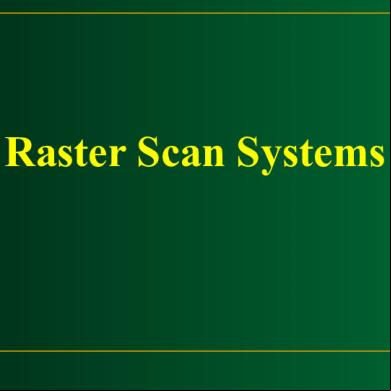Random And Raster Scan Displays 1e184t
This document was ed by and they confirmed that they have the permission to share it. If you are author or own the copyright of this book, please report to us by using this report form. Report 3b7i
Overview 3e4r5l
& View Random And Raster Scan Displays as PDF for free.
More details w3441
- Words: 972
- Pages: 20
RANDOM-SCAN DISPLAYS • When operated as a randomscan display unit, a CRT has the electron beam directed only to the parts of the screen where a picture is to be drawn. Randomscan monitors draw a picture one line at a time and for this reason are also referred to as vector displays
Random-scan Displays 1. Introduction – Random scan systems are also called • Vector Displays • stroke-writing, or • calligraphic displays.
In Random Scan Display picture information or defination for the image to be drawn is stored in a memory called refresh buffer. The display Processor contains the end points of each line to be drawn. 1/28/17
Computer Graphics
3
Random-scan Displays – In order to display a picture, display processing unit executes the various line drawing commands one by one. – Once all the commands in display file are processed the system cycle comes back to the first commonad in the list. This is how refreshing is done in Random Scan CRT. – Refresh rate depends upon the size of the file. – Refreshes by scanning the list 30 to 60 times per second. – More suited for line-drawing applications such as architecture and manufacturing 1/28/17
Computer Graphics
4
Random-scan Displays 2. Architecture of Random Scan System – Simple architecture
(from Donald Hearn and Pauline Baker) 1/28/17
Computer Graphics
5
Display Processor • Purpose of display processor or graphics controller is to keep U free from various graphics chores. Scan Conversion is the major process done by display Processor. Scan Conversion is the process of digitizing a picture defination into a set of intensity values for the purpose of storing them into frame buffer. • Dispaly Processor scan converts lines, curves, arcs, polygons.
Random-scan Displays 3. Advantages: – Good quality lines – High Resolution – Easy animation and requires little memory
4. Disadvantages: – The major disadvantage of random scan system is that thet are line drawing applications cannot display realistic shaded scenes. – Limited screen density, limited to simple, line-based images – Limited color capability. 1/28/17
Computer Graphics
7
Raster-scan Displays 1. Introduction – – – –
1/28/17
Raster-scan display is the most common type of monitor using a CRT. A raster is a matrix of pixels covering the screen area and is composed of raster lines. The electron beam scans the screen from top to bottom one row at a time. Each row is called a scan line. The electron beam is turned on and off to produce a collection of dots painted one row at a time. These will form the image.
Computer Graphics
8
Raster-scan Displays
(from Donald Hearn and Pauline Baker) 1/28/17
Computer Graphics
9
Raster-scan Displays 2. Refresh Procedure – Retracing • Horizontal retrace – beam returns to left of screen • Vertical retrace – bean returns to top left corner of screen
– Blanking • Horizontal Retrace Blanking • Vertical Retrace Blanking
– Interlacing • display first even-numbered lines, then odd-numbered lines • permits to see the image in half the time • useful for slow refresh rates (30 Hz shows as 60 Hz).
1/28/17
Computer Graphics
10
Refresh Rates and Bandwidth • Frames per second (FPS)
Interlaced Scanning • Scan frame 30 times per second • To reduce flicker, divide frame into two fields—one consisting of the even scan lines and the other of the odd scan lines. • Even and odd fields are scanned out alternately to produce an interlaced image.
Raster-scan Displays – Over scanning • Scan lines extended beyond visibility edge as there is limit on speed of sweep generator • Avoid cracking at borders and distortion • Top and Bottom Vertical Over scanning • Left and Right Horizontal Over scanning
– Refresh rate • 24 is a minimum to avoid flicker, corresponding to 24 Hz (1 Hz = 1 refresh per second) • Current raster-scan displays have a refresh rate of at least 60 frames (60 Hz) per second, up to 120 (120 Hz).
1/28/17
Computer Graphics
14
Raster-scan Displays 3. Architecture of Raster Scan System – Simple architecture
(from Donald Hearn and Pauline Baker) 1/28/17
Computer Graphics
15
Raster-scan Displays – Architecture with reserved Frame Buffer
(from Donald Hearn and Pauline Baker) 1/28/17
Computer Graphics
16
Raster-scan Displays – Architecture with reserved Frame Buffer and separate Display Processor
(from Donald Hearn and Pauline Baker) 1/28/17
Computer Graphics
17
Raster-scan Displays 3.1 Frame Buffer – Also called Refresh Buffer, contains picture definition – The image is stored in a frame buffer containing the total screen area and where each memory location corresponds to a pixel. – Consider it as 2-D memory array – E.g. Frame buffer • size 8x8 • Color depth 8 (values 0-7)
– Uses large memory: 640x480 307200 bits 38 kB 1/28/17
Computer Graphics
18
Raster-scan Displays – Bitmap In a monochrome system, each bit is 1 or 0 for the corresponding pixel to be on or off making frame a bitmap. – The display processor scans the frame buffer to turn electron beam on/off depending if the bit is 1 or 0. – Example Bitmap
1/28/17
Computer Graphics
19
Raster vs. Random-scan Displays RASTER
DISPLAY MECHANISM DRAWING UNIT IMAGE STORAGE IMAGE TYPES IMAGE QUALITY
REFRESHING REFRESH RATE ANIMATIONS COLORS COLOR TECHNIQUE 1/28/17
RANDOM
E-beam traces entire screen from upper left corner to bottom right
E-beam can highlight random positions on the screen
Pixel
Line
Frame Buffer
Display File
Can display very complex images with Wire Frame modeling greater accuracy •May be Jagged due to digitization •Diagonal Lines are produced with lower intensity
•Smooth lines as e-beam directly follows the line path •Diagonal Lines are produced with equal intensity
Entire Screen has to be refreshed
Only selected portions are redrawn
Maximum 80 Hz
Higher refresh rates.
ed
Not ing
Higher Color Depth
Lesser colors and shades
Shadow Masking
Beam Penetration
Computer Graphics
20
Random-scan Displays 1. Introduction – Random scan systems are also called • Vector Displays • stroke-writing, or • calligraphic displays.
In Random Scan Display picture information or defination for the image to be drawn is stored in a memory called refresh buffer. The display Processor contains the end points of each line to be drawn. 1/28/17
Computer Graphics
3
Random-scan Displays – In order to display a picture, display processing unit executes the various line drawing commands one by one. – Once all the commands in display file are processed the system cycle comes back to the first commonad in the list. This is how refreshing is done in Random Scan CRT. – Refresh rate depends upon the size of the file. – Refreshes by scanning the list 30 to 60 times per second. – More suited for line-drawing applications such as architecture and manufacturing 1/28/17
Computer Graphics
4
Random-scan Displays 2. Architecture of Random Scan System – Simple architecture
(from Donald Hearn and Pauline Baker) 1/28/17
Computer Graphics
5
Display Processor • Purpose of display processor or graphics controller is to keep U free from various graphics chores. Scan Conversion is the major process done by display Processor. Scan Conversion is the process of digitizing a picture defination into a set of intensity values for the purpose of storing them into frame buffer. • Dispaly Processor scan converts lines, curves, arcs, polygons.
Random-scan Displays 3. Advantages: – Good quality lines – High Resolution – Easy animation and requires little memory
4. Disadvantages: – The major disadvantage of random scan system is that thet are line drawing applications cannot display realistic shaded scenes. – Limited screen density, limited to simple, line-based images – Limited color capability. 1/28/17
Computer Graphics
7
Raster-scan Displays 1. Introduction – – – –
1/28/17
Raster-scan display is the most common type of monitor using a CRT. A raster is a matrix of pixels covering the screen area and is composed of raster lines. The electron beam scans the screen from top to bottom one row at a time. Each row is called a scan line. The electron beam is turned on and off to produce a collection of dots painted one row at a time. These will form the image.
Computer Graphics
8
Raster-scan Displays
(from Donald Hearn and Pauline Baker) 1/28/17
Computer Graphics
9
Raster-scan Displays 2. Refresh Procedure – Retracing • Horizontal retrace – beam returns to left of screen • Vertical retrace – bean returns to top left corner of screen
– Blanking • Horizontal Retrace Blanking • Vertical Retrace Blanking
– Interlacing • display first even-numbered lines, then odd-numbered lines • permits to see the image in half the time • useful for slow refresh rates (30 Hz shows as 60 Hz).
1/28/17
Computer Graphics
10
Refresh Rates and Bandwidth • Frames per second (FPS)
Interlaced Scanning • Scan frame 30 times per second • To reduce flicker, divide frame into two fields—one consisting of the even scan lines and the other of the odd scan lines. • Even and odd fields are scanned out alternately to produce an interlaced image.
Raster-scan Displays – Over scanning • Scan lines extended beyond visibility edge as there is limit on speed of sweep generator • Avoid cracking at borders and distortion • Top and Bottom Vertical Over scanning • Left and Right Horizontal Over scanning
– Refresh rate • 24 is a minimum to avoid flicker, corresponding to 24 Hz (1 Hz = 1 refresh per second) • Current raster-scan displays have a refresh rate of at least 60 frames (60 Hz) per second, up to 120 (120 Hz).
1/28/17
Computer Graphics
14
Raster-scan Displays 3. Architecture of Raster Scan System – Simple architecture
(from Donald Hearn and Pauline Baker) 1/28/17
Computer Graphics
15
Raster-scan Displays – Architecture with reserved Frame Buffer
(from Donald Hearn and Pauline Baker) 1/28/17
Computer Graphics
16
Raster-scan Displays – Architecture with reserved Frame Buffer and separate Display Processor
(from Donald Hearn and Pauline Baker) 1/28/17
Computer Graphics
17
Raster-scan Displays 3.1 Frame Buffer – Also called Refresh Buffer, contains picture definition – The image is stored in a frame buffer containing the total screen area and where each memory location corresponds to a pixel. – Consider it as 2-D memory array – E.g. Frame buffer • size 8x8 • Color depth 8 (values 0-7)
– Uses large memory: 640x480 307200 bits 38 kB 1/28/17
Computer Graphics
18
Raster-scan Displays – Bitmap In a monochrome system, each bit is 1 or 0 for the corresponding pixel to be on or off making frame a bitmap. – The display processor scans the frame buffer to turn electron beam on/off depending if the bit is 1 or 0. – Example Bitmap
1/28/17
Computer Graphics
19
Raster vs. Random-scan Displays RASTER
DISPLAY MECHANISM DRAWING UNIT IMAGE STORAGE IMAGE TYPES IMAGE QUALITY
REFRESHING REFRESH RATE ANIMATIONS COLORS COLOR TECHNIQUE 1/28/17
RANDOM
E-beam traces entire screen from upper left corner to bottom right
E-beam can highlight random positions on the screen
Pixel
Line
Frame Buffer
Display File
Can display very complex images with Wire Frame modeling greater accuracy •May be Jagged due to digitization •Diagonal Lines are produced with lower intensity
•Smooth lines as e-beam directly follows the line path •Diagonal Lines are produced with equal intensity
Entire Screen has to be refreshed
Only selected portions are redrawn
Maximum 80 Hz
Higher refresh rates.
ed
Not ing
Higher Color Depth
Lesser colors and shades
Shadow Masking
Beam Penetration
Computer Graphics
20





